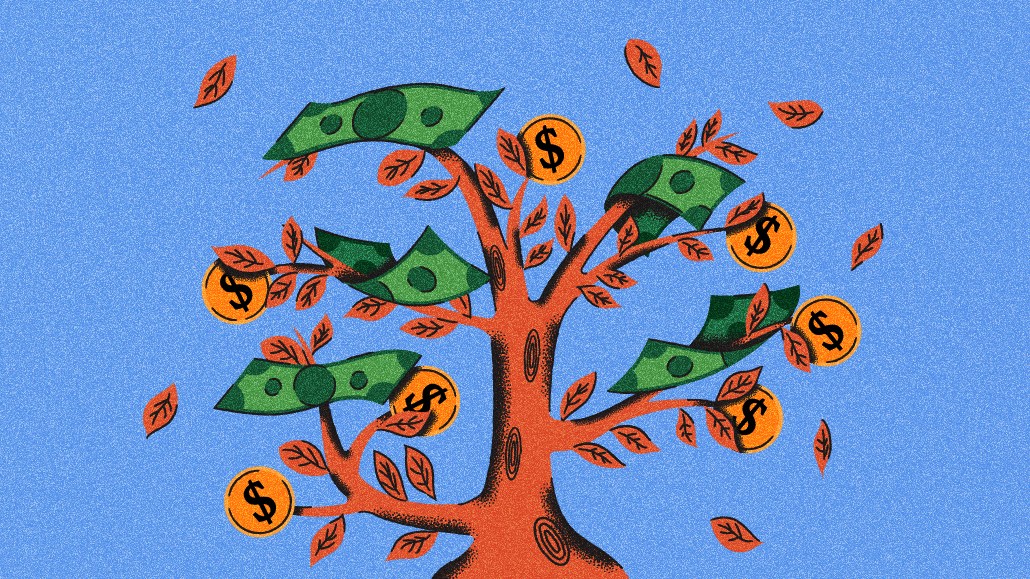Digiday+ Research: Smaller publishers depend the most on digital channels

This research is based on unique data collected from our proprietary audience of publisher, agency, brand and tech insiders. It’s available to Digiday+ members. More from the series →
Media businesses require a delicate balance between the traditional channels the industry is built on and the digital ones that have come to dominate publishing. And that balance looks different depending on the size of the publisher, according to a Digiday+ Research survey of more than 80 publisher professionals.
Digiday’s survey found that small to medium-sized publishers depend more on the revenue they get from digital channels than their larger counterparts.
Nearly two-thirds (65%) of publisher pros who work for small to medium-sized publishers (or those who made less than $50 million in revenue last year) said their companies generate most of their revenue entirely or mostly from digital channels. Meanwhile, half of publisher pros who work for large publishers (or those who made $50 million or more in revenue last year) said the same.
Meanwhile, one-quarter of large publishers said they get most of their revenue entirely or mostly from traditional channels, and the same percentage said their revenue comes about equally from traditional and digital channels. For small to medium-sized publishers, 19% said they get most of their revenue entirely or mostly from traditional channels and 16% said they get most of their revenue equally from traditional and digital channels.
Digging deeper into the data, Digiday’s survey found that publishers are much more likely to say their revenue comes entirely from digital channels than traditional ones — not a groundbreaking point, but definitely an interesting one. In fact, when looking at publishers overall, the largest percentage of respondents said they get their revenue entirely from digital channels (29% said this in 2023, on par with the 28% who said so in 2022). Publisher pros who said their companies generate most of their revenue mostly from digital channels came in at 27% (the same percentage as last year), putting this category in a close second.
This pattern continues with small to medium-sized publishers, although on a bit more of a drastic scale. Nearly half of publisher pros who work for these smaller publishers (45%) said this year their companies get their revenue entirely from digital channels — a significant jump from the 34% who said so last year. Small to medium-sized publishers who said they get their revenue mostly from digital channels came in second in this category too, but, with 21% of respondents saying so this year, it’s by a wide margin. It’s also worth noting that this is a big dip from the 31% who said this last year.
It’s a different story for publisher pros who work for large publishers, though. Digiday’s survey found that large publishers’ revenue strategies are more likely to be more diversified than their small and medium-sized counterparts.
In fact, eighty-five percent of publisher pros who work for large publishers fell in the middle of the scale, saying their companies get most of their revenue mostly from traditional or digital channels or about equally from both types of channels. One-quarter of large publishers said they get most of their revenue mostly from traditional channels, the same percentage said they get their revenue equally from traditional and digital channels, and 35% said they get most of their revenue mostly from digital channels.
There are some additional things worth noting here: First, the percentage of publisher pros who work for large publishers who said their companies get most of their revenue from mostly digital channels saw a big jump from last year to this year, from 21% in Q2 2022 to 35% in Q2 2023. Second, the percentage of large publishers who said they get most of their revenue entirely from digital channels actually saw a bit of a drop-off from last year to this year – from 21% to 15%.
Finally, not one respondent to Digiday’s survey who works for a large publisher said their company gets most revenue entirely from traditional channels.
More in Media

Digiday Scorecard: Publishers rate Big Tech’s AI licensing deals
Digiday has compiled a scorecard grading AI platforms to make sense of the growing number of players in the AI content licensing market.

Publishers are hunting for AI prompt data — now they’re starting to get it from third-party companies
Publishers are finally gaining some visibility into AI search, as new prompt data tools crack open a black box.

Digiday+ Research: Publishers’ growing focus on video doesn’t translate to social platforms
Major publishers have made recent investments in vertical video, but that shift is not carrying over to social media platforms.








